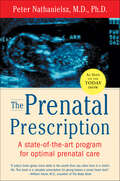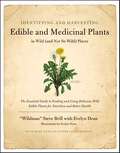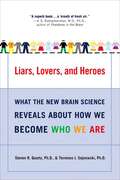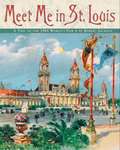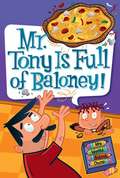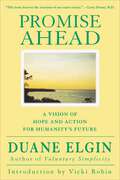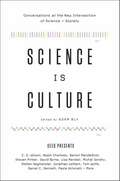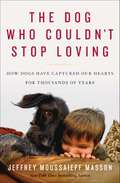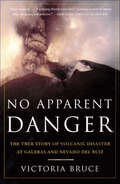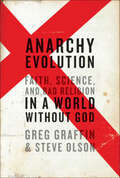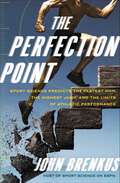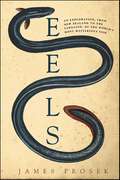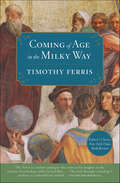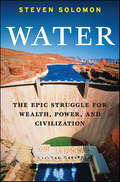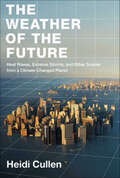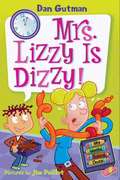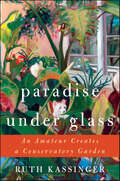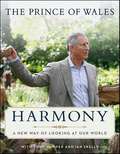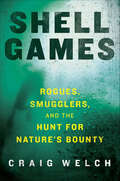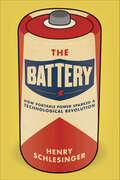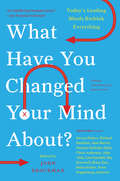- Table View
- List View
The Prenatal Prescription
by Christopher Vaughan Peter NathanielszDid you know that your actions during pregnancy impact your child's health after birth and into adulthood? That what you eat, how much you exercise, your stress level, and your immediate environment are all key factors in determining your baby's predisposition to such conditions as heart disease, obesity, diabetes, stroke, cancer, even depression? Based on more than thirty years of rigorous scientific research, Dr. Nathanielsz's The Prenatal Prescription explains why this is so and what you can do about it.Focusing on the main factors that directly affect the unborn child -- nutrition, stress, toxins, and exercise -- Dr. Nathanielsz lays out a clear and easy-to-follow program for "prenatal programming." He explains the science behind the fetal origins of adult disease, and offers tools that you can use to make your prenatal interaction with your baby memorable and beneficial.Starting before conception, this simple prescription will change forever the way you think about preparing yourself for pregnancy. All parents want a long and healthy life for their child. The Prenatal Prescription explains how to make this a reality.
Identifying & Harvesting Edible and Medicinal Plants (And Not So Wild Places): The Essential Guide to Finding and Using Delicious Wild Edible Plants for Nutrition and Better Health
by Steve Brill Evelyn DeanIdentifying and Harvesting Edible and Medicinal Plants in Wild (and Not So Wild) Places shows readers how to find and prepare more than five hundred different plants for nutrition and better health. It includes information on common plants such as mullein (a tea made from the leaves and flowers suppresses a cough), stinging nettle (steam the leaves and you have a tasty dish rich in iron), cattail (cooked stalks taste similar to corn and are rich in protein), and wild apricots (an infusion made with the leaves is good for stomach aches and digestive disorders). More than 260 detailed line drawings help readers identify a wide range of plants -- many of which are suited for cooking by following the more than thirty recipes included in this book. There are literally hundreds of plants readily available underfoot waiting to be harvested and used either as food or as a potential therapeutic. This book is both a field guide to nature's bounty and a source of intriguing information about the plants that surround us.
Liars, Lovers, and Heroes: What the New Brain Science Reveals About How We Become Who We Are
by Steven R. Quartz Terrence J. SejnowskiThis exciting, timely book combines cutting-edge findings in neuroscience with examples from history and recent headlines to offer new insights into who we are. Introducing the new science of cultural biology, born of advances in brain imaging, computer modeling, and genetics, Drs. Quartz and Sejnowski demystify the dynamic engagement between brain and world that makes us something far beyond the sum of our parts.The authors show how our humanity unfolds in precise stages as brain and world engage on increasingly complex levels. Their discussion embraces shaping forces as ancient as climate change over millennia and events as recent as the terrorism and heroism of September 11 and offers intriguing answers to some of our most enduring questions, including why we live together, love, kill -- and sometimes lay down our lives for others.The answers, it turns out, are surprising and paradoxical: many of the noblest aspects of human nature -- altruism, love, courage, and creativity -- are rooted in brain systems so ancient that we share them with insects, and these systems form the basis as well of some of our darkest destructive traits. The authors also overturn popular views of how brains develop. We're not the simple product of animal urges, "selfish" genes, or nature versus nurture. We survive by creating an ingenious web of ideas for making sense of our world -- a symbolic reality called culture. This we endow to later generations as our blueprint for survival.Using compelling examples from history and contemporary life, the authors show how engagement with the world excites brain chemistry, which drives further engagement, which encourages the development of cultural complexity. They also share provocative ideas on how human development may be affected by changes in our culture. Their insights, grounded in science and far-reaching in their implications, are riveting reading for anyone interested in our past, present, and future.
Meet Me in St. Louis
by Robert JacksonYou are holding a ticket to one of the largest and most magnificent celebrations of all time -- the 1904 St. Louis World's Fair! For seven months nearly twenty million visitors from around the globe flooded the fairgrounds of Forest Park. Many explored the twelve mammoth palaces (made of plaster and horsehair!), which showcased amazing exhibits. Others enjoyed watching the first Olympic Games in the United States, keeping cool all summer with a new treat that became an instant hit -- the ice-cream cone. And everyone loved viewing all 1275 acres of fairgrounds from atop the 265-foot Ferris wheel. Robert Jackson describes the planning, building, events, and memory of a fair that enthralled millions with its magic. In fascinating detail, he captures the energy and imagination of turn-of-the-century America, when fairgoers begged friends and family to meet them in St. Louis.
Mr. Tony Is Full of Baloney! (My Weird School Daze #11)
by Dan Gutman Jim PaillotThe weirdness never stops! Oh no! A.J.'s mom just got a job, so he has to go to After School Kids' Kare. And Mr. Tony, the guy who runs it, is crazy. He wants to get into the Guinness Book of World Records by making the world's largest pizza! Will A.J. and the gang be able to tunnel out of the child-care room and escape to freedom? Run for your lives!
Promise Ahead: A Vision of Hope and Action for Humanity's Future
by Duane ElginThe sequel to Duane Elgin’s bestselling classic Voluntary Simplicity, which changed the lives of thousands and was called the “bible” of the simplicity movement by the Wall Street Journal, Promise Ahead looks beneath the headlines to reveal the deeper currents now changing our lives. Elgin sees two powerful sets of trends converging in the coming decades. The first set he calls “adversity trends.” These include 1. Global climate changes that threaten our food supply2. Massive human population3. Mass extinction of species4. Rapid depletion of crucial natural resources 5. Civil unrest caused by global poverty. The second set he calls “opportunity trends.” These include1. Recognition of the universe as a living system2. The quiet revolution toward simpler ways of living3. Use of the Internet as a tool for social awareness and change4. Growing efforts toward reconciliation of racial, gender, religious, and other differences If we meet these unprecedented challenges, we can make a dramatic leap in our evolutionary journey and will have a very promising future.
Science Is Culture: Conversations at the New Intersection of Science + Society
by Adam BlySeed magazine brings together a unique gathering of prominent scientists, artists, novelists, philosophers and other thinkers who are tearing down the wall between science and culture.We are on the cusp of a twenty-first-century scientific renaissance. Science is driving our culture and conversation unlike ever before, transforming the social, political, economic, aesthetic, and intellectual landscape of our time. Today, science is culture. As global issues—like energy and health—become increasingly interconnected, and as our curiosities—like how the mind works or why the universe is expanding—become more complex, we need a new way of looking at the world that blurs the lines between scientific disciplines and the borders between the sciences and the arts and humanities.In this spirit, the award-winning science magazine Seed has paired scientists with nonscientists to explore ideas of common interest to us all. This book is the result of these illuminating Seed Salon conversations, edited and with an introduction by Seed founder and editor in chief Adam Bly. Science Is Culture includes:E. O. Wilson + Daniel C. DennetSteven Pinker + Rebecca GoldsteinNoam Chomsky + Robert TriversDavid Byrne + Daniel LevitinJonathan Lethem + Janna LevinBenoit Mandelbrot + Paola AntonelliLisa Randall + Chuck HobermanMichel Gondry + Robert StickgoldAlan Lightman + Richard ColtonLaurie David + Stephen SchneiderTom Wolfe + Michael GazzanigaMarc Hauser + Errol Morris
The Dog Who Couldn't Stop Loving: How Dogs Have Captured Our Hearts for Thousands of Years
by Jeffrey Moussaieff MassonDog lovers get ready – Jeffrey Moussaieff Masson, international bestselling author of Dogs Never Lie About Love (which the San Francisco Chronicle calls "winning and wise," and "a charming paean to our best friends"), is back with an inspiring, heart-warming, and deeply personal exploration of the unique relationship between humans and dogs. As in When Elephants Weep, The Face on Your Plate, an The Pig Who Sang to the Moon, Masson blends cultural mythology, scientific research, and stories of his own experiences to tackle deep questions about the emotional lives of humans and animals. His compelling, elegant, and often humorous narrative about the love people feel for dogs (perfect for fans of John Grogan's Marley & Me) gives a new perspective on the extraordinary relationship between our species.
No Apparent Danger: The True Story of Volcanic Disaster at Galeras and Nevado Del Ruiz
by Victoria BruceOn January 14, 1993, a team of scientists descended into the crater of Galeras, a restless Andean volcano in southern Colombia, for a day of field research. As the group slowly moved across the rocky moonscape of the caldera near the heart of the volcano, Galeras erupted, its crater exploding in a barrage of burning rocks and glowing shrapnel. Nine men died instantly, their bodies torn apart by the blast.While others watched helplessly from the rim, Colombian geologist Marta Calvache raced into the rumbling crater, praying to find survivors. This was Calvache's second volcanic disaster in less than a decade. In 1985 Calvache was part of a group of Colombia's brightest young scientists that had been studying activity at Nevado del Ruiz, a volcano three hundred miles north of Galeras. They had warned of the dire consequences of an eruption for months, but their fledgling coalition lacked the resources and muscle to implement a plan of action or sway public opinion. When Nevado del Ruiz erupted suddenly in November 1985, it wiped the city of Armero off the face of the earth and killed more than twenty-three thousand people -- one of the worst natural disasters of the twentieth century.No Apparent Danger links the characters and events of these two eruptions to tell a riveting story of scientific tragedy and human heroism. In the aftermath of Nevado del Ruiz, volcanologists from all over the world came to Galeras -- some to ensure that such horrors would never be repeated, some to conduct cutting-edge research, and some for personal gain. Seismologists, gas chemists, geologists, and geophysicists hoped to combine their separate areas of expertise to better understand and predict the behavior of monumental forces at work deep within the earth.And yet, despite such expertise, experience, and training, crucial data were ignored or overlooked, essential safety precautions were bypassed, and fifteen people descended into a death trap at Galeras. Incredibly, expedition leader Stanley Williams was one of five who survived, aided bravely by Marta Calvache and her colleagues. But nine others were not so lucky.Expertly detailing the turbulent history of Colombia and the geology of its snow-peaked volcanoes, Victoria Bruce weaves together the stories of the heroes, victims, survivors, and bystanders, evoking with great sensitivity what it means to live in the shadow of a volcano, a hair's-breadth away from unthinkable natural calamity, and shows how clashing cultures and scientific arrogance resulted in tragic and unnecessary loss of life.
Proust and the Squid: The Story and Science of the Reading Brain
by Maryanne Wolf"Human beings were never born to read," writes Tufts University cognitive neuroscientist and child development expert Maryanne Wolf. <P><P>Reading is a human invention that reflects how the brain rearranges itself to learn something new. <P><P>In this ambitious, provocative book, Wolf chronicles the remarkable journey of the reading brain not only over the past five thousand years, since writing began, but also over the course of a single child's life, showing in the process why children with dyslexia have reading difficulties and singular gifts. <P><P>Lively, erudite, and rich with examples, Proust and the Squid asserts that the brain that examined the tiny clay tablets of the Sumerians was a very different brain from the one that is immersed in today's technology-driven literacy. <P><P>The potential transformations in this changed reading brain, Wolf argues, have profound implications for every child and for the intellectual development of our species.
Here Is a Human Being
by Misha AngristThe first in-depth look at personal genomics: its larger-than-life research subjects; its entrepreneurs and do-it-yourselfers; its technology developers; the bewildered and overwhelmed physicians and regulators who must negotiate it; and what it means to be a "public genome" in a world where privacy is already under siege In 2007, Misha Angrist became the fourth subject in the Personal Genome Project, George Church's ambitious plan to sequence the entire genomic catalog: every participant's twenty thousand-plus genes and the rest of his or her 6 billion base pairs. Church hopes to better understand how genes influence our physical traits, from height and athletic ability to behavior and weight, and our medical conditions, from cancer and diabetes to obesity and male pattern baldness. Now Angrist reveals startling information about the experiment's participants and scientists; how the experiment was, is, and will be conducted; the discoveries and potential discoveries; and the profound implications of having an unfiltered view of our hardwired selves for us and for our children. DNA technology has already changed our health care, the food we eat, and our criminal justice system. Unlocking the secrets of our genomes opens the door not only to helping us understand why we are the way we are and potentially fixing what ails us but also to many other concerns: What exactly will happen to this information? Will it become just another marketing tool? Can it help us understand our ancestry, or will it merely reinforce old ideas of race? Can personal genomics help fix the U.S. health care system? Here Is a Human Being explores these complicated questions while documenting Angrist's own fascinating journey-one that tens of thousands of us will soon make.
Anarchy Evolution: Faith, Science, and Bad Religion in a World Without God
by Greg Graffin Steve Olson“Take one man who rejects authority and religion, and leads a punk band. Take another man who wonders whether vertebrates arose in rivers or in the ocean….Put them together, what do you get? Greg Graffin, and this uniquely fascinating book.” —Jared Diamond, author of Guns, Germs, and SteelAnarchy Evolution is a provocative look at the collision between religion and science, by an author with unique authority: UCLA lecturer in Paleontology, and founding member of Bad Religion, Greg Graffin. Alongside science writer Steve Olson (whose Mapping Human History was a National Book Award finalist) Graffin delivers a powerful discussion sure to strike a chord with readers of Richard Dawkins’ The God Delusion or Christopher Hitchens God Is Not Great. Bad Religion die-hards, newer fans won over during the band’s 30th Anniversary Tour, and anyone interested in this increasingly important debate should check out this treatise on science from the god of punk rock.
The Perfection Point: Sport Science Predicts the Fastest Man, the Highest Jump, and the Limits of Athletic Performance
by John BrenkusWhat's the fastest a human can run the 100-meter sprint? What's the longest a human can hold his breath? What are the limits of human performance?Welcome to The Perfection Point.Until 1954, common wisdom and scientific knowledge considered a sub-four-minute mile an impossible feat for a human. But then Roger Bannister broke that mark, followed quickly by a host of other athletes. Today the world record stands at 3 minutes, 43 seconds, yet even that number doesn't tell the full story of how fast humans can run a mile—records are a mark of how well people have done, not how well they can do. What's the actual limit? The answer lies in The Perfection Point.In this fascinating and thought-provoking book, John Brenkus, the host, co-creator, and executive producer of ESPN's Sport Science, ventures across the sports world to provide an in-depth look at the absolute limits of human performance. Beginning with the current world records for a variety of sports, Brenkus finds the “perfection point” for each, zeroing in on the speeds, heights, distances, and times that humans will get closer to but never exceed.Combining cutting-edge science with the fundamentals of each sport, Brenkus answers questions as old as competition itself, exploring the outer realm of what's possible in athletics. Using engrossing and accessible language, he applies statistics, physics, and physiology to uncover perfection points such as: the highest dunkthe longest home runthe fastest milethe longest golf drivethe heaviest bench pressIntriguing, detailed, and controversial, the answers that Brenkus provides are essential reading for every sports fan. For years, coaches, pundits, and experts have speculated about the extremes of human ability. The Perfection Point finally provides the answers.
Eels: An Exploration, from New Zealand to the Sargasso, of the World's Most Mysterious Fish
by James Prosek“Eels [is] more than a fish book. It is an impassioned defense of nature itself. . . . [Prosek] passes on the truth that the often disdained eel, like all migratory fish, is vital and mysterious and worthy of our full effort to bring it back.” — New York Times Book Review“A wonderful account of far-flung travels in pursuit of the secrets of the earth’s most mysterious fish. . . . Fascinating and beautifully rendered.” — Peter MatthiessenFamous for his deeply informed, compulsively readable books on trout, James Prosek (whom the New York Times has called “the Audubon of the fishing world”) takes on nature’s quirkiest and most enigmatic fish: the eel. Fans of Mark Kurlansky’s Cod and The Big Oyster or Trevor Corson’s The Secret Life of Lobsters will love Prosek’s probing exploration of the hidden deep-water dwellers. With characteristically captivating prose and lavish illustrations, Prosek demystifies the eel’s unique biology and bizarre mating routines, and illuminates the animal’s varied roles in the folklore, cuisine, and commerce of a variety of cultures.
Coming of Age in the Milky Way
by Timothy FerrisFrom the second-century celestial models of Ptolemy to modern-day research institutes and quantum theory, this classic book offers a breathtaking tour of astronomy and the brilliant, eccentric personalities who have shaped it. From the first time mankind had an inkling of the vast space that surrounds us, those who study the universe have had to struggle against political and religious preconceptions. They have included some of the most charismatic, courageous, and idiosyncratic thinkers of all time. In Coming of Age in the Milky Way, Timothy Ferris uses his unique blend of rigorous research and captivating narrative skill to draw us into the lives and minds of these extraordinary figures, creating a landmark work of scientific history.
Long for This World
by Jonathan WeinerFrom the Pulitzer Prize-winning science writer Jonathan Weiner comes a fast-paced and astonishing scientific adventure story: has the long-sought secret of eternal youth at last been found? In recent years, the dream of eternal youth has started to look like more than just a dream. In the twentieth century alone, life expectancy increased by more than thirty years-almost as much time as humans have gained in the whole span of human existence. Today a motley array of scientists, researchers, and entrepreneurs believe that another, bigger leap is at hand-that human immortality is not only possible, but attainable in our own time. Is there genius or folly in the dreams of these charismatic but eccentric thinkers? In Long for This World, Jonathan Weiner, a natural storyteller and an intrepid reporter with a gift for making cutting-edge science understandable, takes the reader on a whirlwind intellectual quest to find out. From Berkeley to the Bronx, from Cambridge University to Dante's tomb in Ravenna, Weiner meets the leading intellectuals in the field and delves into the mind-blowing science behind the latest research. He traces the centuries-old, fascinating history of the quest for longevity in art, science, and literature, from Gilgamesh to Shakespeare, Doctor Faustus to "The Curious Case of Benjamin Button." And he tells the dramatic story of how aging could be conquered once and for all, focusing on the ideas of those who believe aging is a curable disease. Chief among them is the extraordinary Aubrey de Grey, a garrulous Englishman who bears more than a passing resemblance to Methuselah (at 969 years, the oldest man in the Bible) and who is perhaps immortality's most radical and engaging true believer. A rollicking scientific adventure story in the grand manner of Oliver Sacks, Long for This World is science writing of the highest order and with the highest stakes. Could we live forever? And if we could...would we want to?
Water: The Epic Struggle for Wealth, Power, and Civilization
by Steven Solomon“I read this wide-ranging and thoughtful book while sitting on the banks of the Ganges near Varanasi—it's a river already badly polluted, and now threatened by the melting of the loss of the glaciers at its source to global warming. Four hundred million people depend on it, and there's no backup plan. As Steven Solomon makes clear, the same is true the world over; this volume will give you the background to understand the forces that will drive much of 21st century history.” —Bill McKibben In Water, esteemed journalist Steven Solomon describes a terrifying—and all too real—world in which access to fresh water has replaced oil as the primary cause of global conflicts that increasingly emanate from drought-ridden, overpopulated areas of the world. Meticulously researched and undeniably prescient, Water is a stunningly clear-eyed action statement on what Robert F Kennedy, Jr. calls “the biggest environmental and political challenge of our time.”
The Weather of the Future: Heat Waves, Extreme Storms, and Other Scenes from a Climate-Changed Planet
by Heidi Cullen“A scorching vision of what life might be like in the warmer world that is already on its way. " — Michiko Kakutani, New York Times“Vivid and compelling, this book shows what life will be like in a warming world. Essential reading for anyone who’s planning to inhabit the planet for the next few decades.” — Elizabeth Kolbert, author of Field Notes from a CatastropheFrom Heidi Cullen, one of America’s foremost experts on weather and climate change and a senior research scientist with Climate Central, a fascinating and provocative book that predicts what different parts of the world will look like in the year 2050 if current levels of carbon emissions are maintained.Dr. Heidi Cullen, one of the world’s foremost climatologists and environmental journalists, offers a new way of viewing the climate-change phenomenon, not as some future event but as something happening right now in our own backyard. In this groundbreaking, provocative work, Dr. Cullen combines the latest scientific research with state-of-the-art climate-model projections to create climate-change scenarios for seven of the most at-risk locations around the globe.From the Central Valley of California, where coming droughts will jeopardize the entire state’s water supply, to New York City, whose infrastructure is extremely vulnerable to even a relatively weak Category 3 hurricane, to Greenland, where warmer temperatures will give access to mineral wealth buried beneath ice sheets for millennia, Cullen illustrates how, if left unabated, climate change will transform every corner of the world by midcentury—and no two regions will be affected in quite the same way.
Mrs. Lizzy Is Dizzy! (My Weird School Daze #9)
by Dan Gutman Jim PaillotThe weirdness never stops! Help! With the Recess Enrichment Program, A.J. and the gang have to take classes even during recess! The new teacher, Mrs. Lizzy, teaches how to make balloon animals, how to compost worms, and lots of other weird useless skills that nobody would ever want to know in a million hundred years!
Paradise Under Glass: The Education of an Indoor Gardener
by Ruth KassingerParadise Under Glass is a witty and absorbing memoir about one woman’s unlikely desire to build, stock, and tend a small conservatory in her suburban Maryland home. Ruth Kassinger’s wonderful story of the unique way she chose to cope with the profound changes in her life—a book that will delight readers of Eat, Pray, Love and I Feel Bad About My Neck—is interwoven with the fascinating history of conservatories from the Renaissance orangeries to the glass palaces of Kew.
Harmony: A New Way of Looking at Our World
by The Prince of Wales Tony Juniper Ian SkellyFor the first time, His Royal Highness Charles, the Prince of Wales, shares his views on how mankind’s most pressing modern challenges are rooted in our disharmony with nature. In the vein of Al Gore’s An Inconvenient Truth and Van Jones’ Green Collar Economy, Prince Charles presents the compelling case that solutions to our most dire crises—from climate change to poverty—lie in regaining a balance with the world around us.
Shell Games: Rogues, Smugglers, and the Hunt for Nature's Bounty
by Craig WelchShell Games is a cops-and-robbers tale set in a double-crossing world where smugglers fight turf wars over some of the world's strangest marine creatures.Puget Sound sits south of the border between the U.S. and Canada and is home to the magnificent geoduck (pronounced "gooey duck"), the world's largest burrowing clam. Comically proportioned but increasingly fashionable as seafood, the geoduck has been the subject of pranks, TV specials, and gourmet feasts. But this shellfish is so valuable it is also traded for millions of dollars on the black market— a world where outlaw scuba divers dodge cops while using souped-up boats, night-vision goggles, and weighted belts to pluck the succulent treasures from the sea floor. And the greatest dangers come from rival poachers who resort to arson and hit men to eliminate competition and stake their claim in the geoduck market. Detective Ed Volz spent his life chasing elk-antler thieves, bobcat smugglers, and eagle talon poachers. Now he was determined to find the kingpin of the geoduck underworld. He and a team of federal agents set up illegal sales, secretly recorded conversations, and photographed hand-offs from the bushes. For years, they tracked a rogues' gallery of lawbreakers, who eventually led them to the biggest thief of all— a darkly charming con man who called himself the "GeoduckGotti" and who worked both sides of the law.In Shell Games, veteran environmental journalist Craig Welch delves into the wilds of our nation's waters and forests in search of some of America's most unusual criminals and the cops who are on a mission to take them down. This thrilling examination of the international black market for wildlife is filled with butterfly thieves, bear slayers, and shark-trafficking pastors— all part of one of the largest illegal trades in the world.
The Battery: How Portable Power Sparked a Technological Revolution
by Henry SchlesingerIn the tradition of Mark Kurlansky's Cod and David Bodanis's E=MC2, The Battery is the first popular history of the technology that harnessed electricity and powered the greatest scientific and technological advances of our time.What began as a long-running dispute in biology, involving a dead frog's twitching leg, a scalpel, and a metal plate, would become an invention that transformed the history of the world: the battery. From Alessandro Volta's first copper-and-zinc model in 1800 to twenty-first-century technological breakthroughs, science journalist Henry Schlesinger traces the history of this essential power source and demonstrates its impact on our lives.Volta's first battery not only settled the frog's leg question, it also unleashed a field of scientific research that led to the discovery of new elements and new inventions, from Samuel Morse's telegraph to Alexander Graham Bell's telephone to Thomas Edison's incandescent lightbulb. And recent advances like nanotechnology are poised to create a new generation of paradigm-shifting energy sources.Schlesinger introduces the charlatans and geniuses, paupers and magnates, attracted to the power of the battery, including Michael Faraday, Guglielmo Marconi, Gaylord Wilshire, and Hugo Gernsback, the publisher and would-be inventor who coined the term "science fiction." A kaleidoscopic tour of an ingenious invention that helped usher in the modern world, The Battery is as entertaining as it is enlightening.
What Have You Changed Your Mind About?
by Mr John BrockmanEven geniuses change their minds sometimes.Edge (www.edge.org), the influential online intellectual salon, recently asked 150 high-powered thinkers to discuss their most telling missteps and reconsiderations: What have you changed your mind about? The answers are brilliant, eye-opening, fascinating, sometimes shocking, and certain to kick-start countless passionate debates.Steven Pinker on the future of human evolution * Richard Dawkins on the mysteries of courtship * SAM HARRIS on the indifference of Mother Nature * Nassim Nicholas Taleb on the irrelevance of probability * Chris Anderson on the reality of global warming * Alan Alda on the existence of God * Ray Kurzweil on the possibility of extraterrestrial life * Brian Eno on what it means to be a "revolutionary" * Helen Fisher on love, fidelity, and the viability of marriage * Irene Pepperberg on learning from parrots . . . and many others.
What Have You Changed Your Mind About?
by Mr John BrockmanEven geniuses change their minds sometimes.Edge (www.edge.org), the influential online intellectual salon, recently asked 150 high-powered thinkers to discuss their most telling missteps and reconsiderations: What have you changed your mind about? The answers are brilliant, eye-opening, fascinating, sometimes shocking, and certain to kick-start countless passionate debates.Steven Pinker on the future of human evolution * Richard Dawkins on the mysteries of courtship * SAM HARRIS on the indifference of Mother Nature * Nassim Nicholas Taleb on the irrelevance of probability * Chris Anderson on the reality of global warming * Alan Alda on the existence of God * Ray Kurzweil on the possibility of extraterrestrial life * Brian Eno on what it means to be a "revolutionary" * Helen Fisher on love, fidelity, and the viability of marriage * Irene Pepperberg on learning from parrots . . . and many others.
